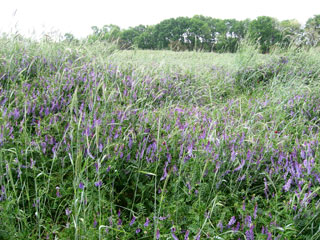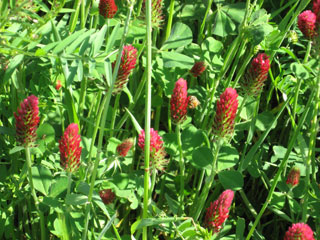Onto an already overwhelmed world stage—what with Paris Hilton's jail sentence to consider on top of Anna Nicole Smith's will—I'm going to try with utmost daring to interject a frank discussion of green manures. Green what? On a food website? Are you out of your…? Here is green manure number one, a lovely purple wisteria-in-miniature-like flower whose fragrance brings to mind anything but manure. It's called hairy vetch:

Back in September, I seeded three acres of hairy vetch, together with winter rye. And now I'm about to reap the benefits. As soon as I'm through writing this, I am going outside to mow my lovely three acres of purple flowers. Later in the week, I will turn the mowed rye and vetch combination into the ground with my plow and then wait three or four weeks to plant some tomatoes and squash in the same field. Three or four weeks is about the length of time it will take for all of the hardworking good guys in the soil—bacteria, fungi, algae, nematodes, earthworms, and the microbes known as actinomycetes—to start breaking down the many tons of plowed-under organic matter, converting all that decomposing hairy vetch and rye into a healthy and balanced meal for the stuff my customers want me to grow. By feeding a new generation with the abundant rot of an old generation, I am essentially trying to farm the way Mother Nature did for millions of years, before the "conventional" methods of mankind evolved. Unlike chemical fertilizers, the nutrients made available by green manures do not leach through the soil and wind up in places like the Chesapeake Bay and the Gulf of Mexico, where the phytoplanktons growing out of control on these fertilizers steal life-giving oxygen from fish, shrimp and other marine creatures. In the Gulf of Mexico, the resulting "dead zone" grows to the size of New Jersey every July. Since the ethanol craze has farmers planting more fertilizer-dependent corn this year than has been planted since the forties, you can expect these dead zones to grow. There are billions of bacteria in every gram of soil. And if I had the time, I could come up with a billion reasons, besides the Gulf of Mexico dead zone, why it is better in the long run for a farmer to hew towards Mother Nature's proven methods. Here is another reason, green manure number two, crimson clover:

Unfortunately, you can't hear the sound that accompanies this lovely picture, the deep, reassuring hum of tens, maybe hundreds of thousands, of bees hovering about the clover. This is one corner of the planet where honeybees are alive and well. Such lovely flowers. Such amorous bees. I'm not sure I can bring myself to plow under this green manure.



 Pinterest
Pinterest


